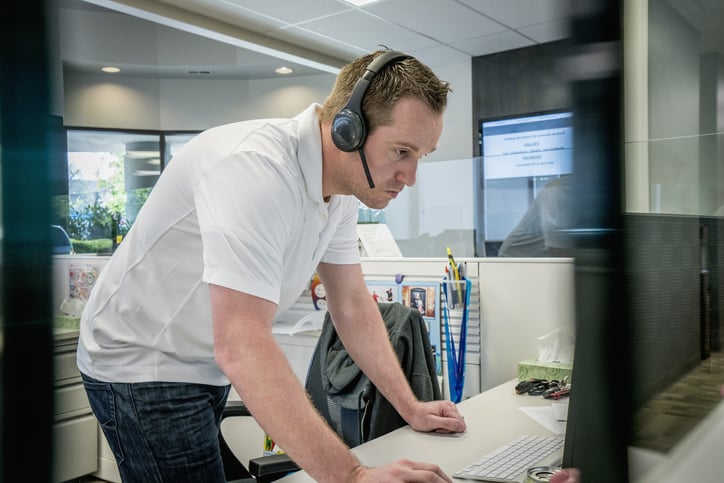Case Study: Saint Louis University
A conversation with John Heartlein

Thanks for giving me a little bit of your time John. First tell me a little bit about Saint Louis University?
We are a private, Jesuit University with about 14,000 students and 6,000 staff members. We have a whole range of undergraduate and graduate programs and, until recently, we also ran a clinical operation called SLUCare with about 1,600 physicians and 20 remote clinical locations.
Very good, and tell me about your role and your team.
So, I’ve been here 14 years. My role now is Director of Service Operations; I’m in charge of server storage and backup infrastructure and I also have responsibilities for some of our cloud infrastructure, database operation, and maintenance.
And tell me how you first came into contact with US Cloud.
Well, we were unfortunately faced with budget cuts. So, at the same time we reduced our headcount by 56%, my Premier Support budget was cut right down the middle. I had to scramble to figure out what we were going to do. And truly, I think I found you guys through Google search.
Ouch.
Oddly enough, the changes actually set us up quite well for the COVID crisis. We had all the technology in place to switch to remote. All of our IT support was already mostly remote and that transition I think would have been harder if we had still been organized in the same fashion.
What was it like before you found US Cloud? Tell us what that was like working with Premier?
It was horrible. I mean, flat out. I had a technical account manager that I had to constantly manage. It felt like it was such a hassle to do anything. Add and remove people from the portal. The whole process of converting from proactive to reactive support hours. The TAM, to me, sometimes it felt like they were a Sales Rep for Microsoft.
And we didn’t have a huge contract with them to begin with, but…all the time I had to spend managing that relationship. It just became a problem. So, when my budget got cut, I was already looking for other solutions.
And what was that move like? There must have been some level of concern or friction about moving away from the OEM and going to 3rd party support?
There really wasn’t. At that time, I think everyone was feeling the frustration. The Director of End User Support or the Identity Architect, they had felt the pain of working with Microsoft. When we started that relationship in 2012, Premier Support was great. We could get on the phone. Our TAM would get a Tier 4 engineer or a product owner from Microsoft and we could work through the challenges.
After that? Probably late 2016, 2017, there was just a big drop off on response times and overall ability to get what we needed quickly. And then, in the meantime, the TAM was trying to coordinate meetings with other folks at SLU to talk about solutions with the Microsoft Sales Team, and that just didn’t sit right with me.
OK, so you decide to make the switch. Do you remember what your first impressions were when you came over to US Cloud? Of the service and the experience?
They were great. I mean, truly, my TAM at the time, it was just so easy. We had a set number of hours and the hours didn’t expire and they weren’t dedicated to one type of service versus another. And I had a monthly touch base. It was just way easier. And as we brought in the managed service provider, I felt US Cloud gave them a little bit of a boost.
At one point, we had a problem where the engineer helping us at that time, there was some operational problem with the Windows Server, but it also involved Cisco, and that engineer was able to work with the Cisco engineer. There was no problem having multiple companies on the phone. Nobody said, “well, it’s Cisco’s problem.”
Another time, we had a big problem decommissioning a domain controller, which one would normally expect to be a very simple operational task, but it caused major performance issues with our network DNS resolution.
I remember the engineer at the time, all of our domain controllers were built on something with no GUI, no graphical user interface. So, it’s a lot harder to troubleshoot on that, and he was able to get in there and work in core. He wasn’t super happy that we were running core, but he was able to get in there and resolve the problem using basically PowerShell commands and get us back in working order.
That’s a great story John. Anything else you want to mention about your experience so far?
Well, there’s always a quick response. I think the first response is always within 15 minutes. Sometimes actually getting on a phone or on a conference call and getting to work on the problem takes longer, but we do always have that 15-minute response. So, I think that’s been really good. Also, the TAM keeps an eye on my tickets for me. If there’s one that’s dragging because of something, I get an alert from Derek and I’m able to respond appropriately to those issues. There were times with Microsoft where we’ve burned 15 hours and have nothing to show for it. Some tickets are more complex, so they do take time. But I just really feel like US Cloud is focused on delivering value.
